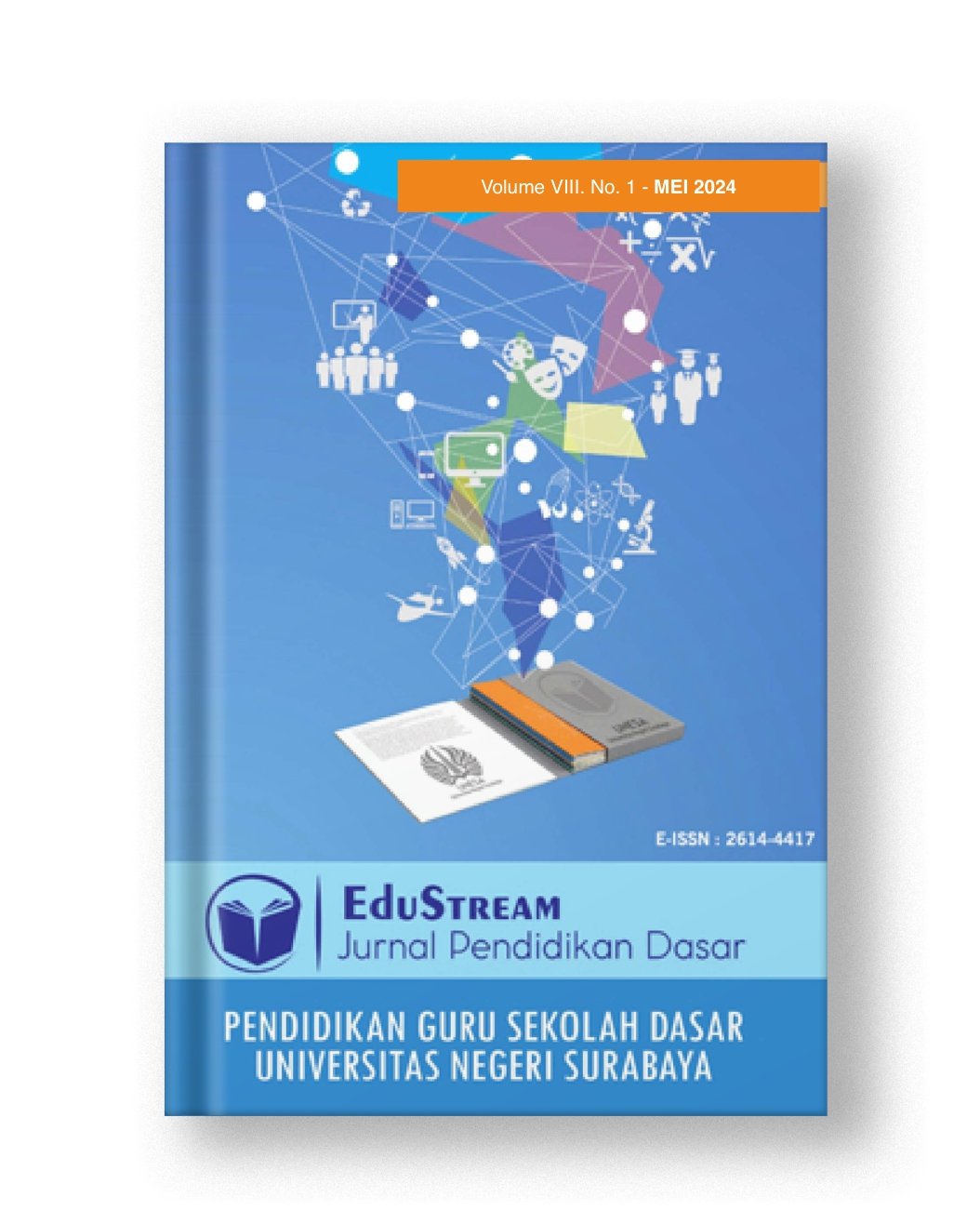STUDY ON READING LITERACY IN ELEMENTARY SCHOOLS: BIBLIOMETRIC ANALYSIS 2013-2023
DOI:
https://doi.org/10.26740/eds.v8n1.p58-70Keywords:
Reading Literacy, Elementary Schools, Bibliometric AnalysisAbstract
This study examines scholarly literature on reading literacy in elementary schools from 2013 to 2023 through bibliometric analysis. A total of 649 documents from the Scopus database were analyzed to identify research trends, geographic distribution, researcher collaborations, and frequently discussed topics. Findings indicate a significant increase in publications, particularly in the last five years, reflecting growing interest in reading literacy. The most cited article, “Closing the achievement gap through modification of neurocognitive and neuroendocrine function” by Blair & Raver (2014), highlights effective interventions in reading literacy. The journal “Reading Teacher” is the most productive source with 20 papers, and Florida State University is the most prolific institution. The United States contributes the most papers (326), showing leadership in this field. VOSviewer thematic mapping shows primary focuses on teaching practices, intervention effectiveness, and learning experiences. Density visualizations show that literacy practices, experiences, effects, and interventions are frequently researched themes. These findings offer valuable insights for researchers, educators, and policymakers to reimprove ading literacy in elementary schools, emphasizing the importance of institutional collaboration and evidence-based interventions in improving educational outcomes.
References
Blair, C., & Raver, C. C. (2014). Closing the achievement gap through modification of neurocognitive and neuroendocrine function: Results from a cluster randomized controlled trial of an innovative approach to the education of children in kindergarten. PloS one, 9(11), e112393.
Carlisle, J. F. (2010). Effects of instruction in morphological awareness on literacy achievement: An integrative review. Reading research quarterly, 45(4), 464-487.
Contesse, V. A., Campese, T., Kaplan, R., Mullen, D. A., Pico, D. L., Gage, N. A., & Lane, H. B. (2021). The effects of an intensive summer literacy intervention on reader development. Reading & Writing Quarterly, 37(3), 221-239.
Cooper, B. R., Moore, J. E., Powers, C. J., Cleveland, M., & Greenberg, M. T. (2014). Patterns of early reading and social skills associated with academic success in elementary school. Early Education and Development, 25(8), 1248-1264.
Darling-Hammond, L., Flook, L., Cook-Harvey, C., Barron, B., & Osher, D. (2020). Implications for educational practice of the science of learning and development. Applied developmental science, 24(2), 97-140.
Dini, J. P. A. U. (2022). Peran Orang Tua dalam Menyediakan Home Literacy Environment (HLE) pada Anak Usia Dini. Jurnal Obsesi: Jurnal Pendidikan Anak Usia Dini, 6(3), 1367-1381.
Ghani, N. A., Teo, P. C., Ho, T. C., Choo, L. S., Kelana, B. W. Y., Adam, S., & Ramliy, M. K. (2022). Bibliometric analysis of global research trends on higher education internationalization using Scopus database: Towards sustainability of higher education institutions. Sustainability, 14(14), 8810.
Goodwin, A. P., & Ahn, S. (2013). A meta-analysis of morphological interventions in English: Effects on literacy outcomes for school-age children. Scientific Studies of reading, 17(4), 257-285.
Graham, S., Harris, K. R., Kiuhara, S. A., & Fishman, E. J. (2017). The relationship among strategic writing behavior, writing motivation, and writing performance with young, developing writers. The Elementary School Journal, 118(1), 82-104.
Hallinger, P. (2013). A conceptual framework for systematic reviews of research in educational leadership and management. Journal of Educational Administration, 51(2), 126-149.
Hiebert, E. H., & Mesmer, H. A. E. (2013). Upping the ante of text complexity in the Common Core State Standards: Examining its potential impact on young readers. Educational Researcher, 42(1), 44-51.
Huang, Z., Sindakis, S., Aggarwal, S., & Thomas, L. (2022). The role of leadership in collective creativity and innovation: Examining academic research and development environments. Frontiers in Psychology, 13, 1060412.
Jan van Eck, J., & Waltman, L. (2021). VOSviewer Manual. (Manual for VOSviewer Version 1.6. 17).
Joyce, B. R., & Showers, B. (2002). Student achievement through staff development (Vol. 3). Alexandria, VA: Association for Supervision and Curriculum Development.
Moll, K., Ramus, F., Bartling, J., Bruder, J., Kunze, S., Neuhoff, N., & Landerl, K. (2014). Cognitive mechanisms underlying reading and spelling development in five European orthographies. Learning and instruction, 29, 65-77.
Niklas, F., & Schneider, W. (2017). Home learning environment and development of child competencies from kindergarten until the end of elementary school. Contemporary Educational Psychology, 49, 263-274.
Ntelioglou, B. Y., Fannin, J., Montanera, M., & Cummins, J. (2014). A multilingual and multimodal approach to literacy teaching and learning in urban education: A collaborative inquiry project in an inner city elementary school. Frontiers in psychology, 5, 533.
Shanahan, C., & Shanahan, T. (2014). Does disciplinary literacy have a place in elementary school?. The Reading Teacher, 67(8), 636-639.
Shanahan, T., & Shanahan, C. (2008). Teaching disciplinary literacy to adolescents: Rethinking content-area literacy. Harvard educational review, 78(1), 40-59.
Snow, C. E., & Matthews, T. J. (2016). Reading and language in the early grades. The future of children, 57-74.
Tahmidaten, L., & Krismanto, W. (2020). Permasalahan budaya membaca di Indonesia (Studi pustaka tentang problematika & solusinya). Scholaria: Jurnal Pendidikan Dan Kebudayaan, 10(1), 22-33.
Verma, R. K., Gupta, S., & Illinich, S. (2024). Technology-enhanced personalized learning in higher education. In Advances in Technological Innovations in Higher Education (pp. 71-92). CRC Press.
Walsh, M. (2011). Multimodal literacy: Researching classroom practice. Primary English Teaching Association.
Zupic, I., & ?ater, T. (2015). Bibliometric methods in management and organization. Organizational research methods, 18(3), 429-472.
Downloads
Published
How to Cite
Issue
Section
License
Authors who publish with this journal agree to the following terms :
The articles published in this journal are protected by copyright. The copyright remains with the authors of the articles, but the publishing license is held by Universitas Negeri Surabaya as the journal manager. This license, Creative Commons Attribution-ShareAlike (CC BY-SA), allows readers to copy, distribute, and adapt the work, provided that proper attribution is given to the original author and any modified work is published under the same license. This license grants the freedom to use the work both commercially and non-commercially, as long as it adheres to the terms outlined in the license.
 Abstract views: 308
,
Abstract views: 308
, PDF Downloads: 217
PDF Downloads: 217

















